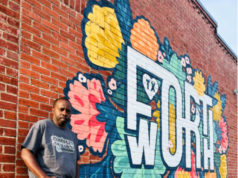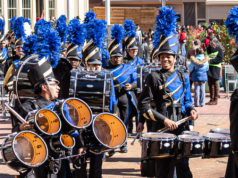The Southwestern Exposition and Livestock Show, currently under way at the city-owned Will Rogers Memorial Center, has been a big deal in Cowtown for more than a century. Farming and ranching no longer play much of a part in Fort Worth’s economy, but the show and what it stands for are still a major part of local culture.
Also known as the Fort Worth Stock Show & Rodeo, it’s three weeks of rodeo with that little monkey riding on the back of the dog and herding goats. It’s a chance for city-bred kids to schmooze with cows and pigeons and llamas. It’s a time to get the cowboy hat and big belt buckle out of the closet and play cowboy for a time. It gives FFA kids and 4-H-ers the chance to show their skills and get some cash rewards. It’s corny dogs and cow poop, cotton candy and carney workers, petting zoos and rodeo clowns.
More than 900,000 visitors go to the event every year, and economic studies done by the city and the stock show indicate that roughly $100 million in economic activity comes to town with it. According to Internal Revenue Service filings, the show costs about $9.2 million to put on each year and brings in about $12.5 million in gross receipts. That’s a lot of money flying around, especially in a city-run facility, with a show put on by a nonprofit organization. The question is, where does it all end up?
The answer seems to be, in part, that the city makes little money off the huge, historic three-week event – perhaps not even enough to cover its costs. While the stock show organization has contributed millions of dollars over the years to improvements in and around the Will Rogers property, the group also appears to have the sweetest of deals on lease costs with the city. The stock show’s charitable mission, according to its files with the IRS, is to put on livestock and farm-product exhibitions “to promote the breeding, raising, and marketing of better cattle and agricultural products.” But the $93,000 or so the show gives out in college scholarships to ag students each year is a drop in the bucket compared to that awarded by comparable stock shows in other Texas cities.
Some of the folks who do come out ahead: stock show executives, including the president, who made $425,000 last year (about the same as public-university presidents around the country and more than James Spaniolo makes as president of the University of Texas at Arlington), an executive vice president who was paid $250,000, and five other employees making more than $100,000, including an “executive assistant” with an annual pay of $127,500.
Linda Lampkin, research director for the Economic Research Institute, which tracks compensation levels for nonprofit executives, said the salaries of stock show president W.R. Watt and the others “are definitely on the high edge … when you compare them to similar nonprofits.” In a group of about 600 nonprofits with similar revenues, Lampkin said, the average annual pay for a CEO was $120,000. Many nonprofit groups, of course, operate all year, rather than intensively for just a few weeks – though the IRS filings say work on the stock show continues year-round.
“This sounds like a trade show, and the IRS is starting to look closely at a lot of organizations like this, given the huge federal budget deficit,” and the tax dollars the government could be collecting were it not for the groups’ nonprofit status, said Daniel Borochoff, president of the American Institute of Philanthropy. The institute tracks charitable nonprofits. “The question that needs to be asked is what is the benefit for the public by using their tax dollars? Because they may say they are not being subsid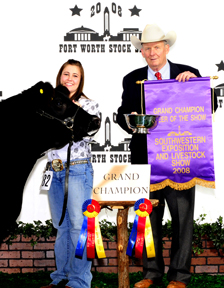 ized by the public, but they really are. Sounds like they are getting subsidized by the city as well.”
ized by the public, but they really are. Sounds like they are getting subsidized by the city as well.”
The Will Rogers Memorial Center has 85 acres of land, including 45 acres under roof, and the stock show uses every bit of it. That means the stock show is leasing more than 3.7 million square feet of space from the city for 30 days every year. The organization also uses about 10,000 square feet of space in the Will Rogers complex year-round for its offices.
Since 1993, the stock show has paid the city $100,000 annually for use of that space, plus another $20,000 each year for improvements to the facility. In addition, the organization pays for utilities and clean-up, which together cost $940,000 in 2008. When city employees work extra hours during the stock show, that overtime pay is also picked up by the nonprofit. And the group pays more than $200,000 a year to retire bonds used to build a new livestock building.
Based on commercial office space rates in the area – about $18 per square foot on average – the stock show office space alone is worth about $180,000 per year, let alone the millions of square feet that the rodeo and stock show occupies for those 30 days.
There is no percentage sharing with the city of any of the revenue generated by the show, exposition, or rodeo. The stock show group keeps every cent generated from tickets, parking fees, exhibitor leases, concessions, livestock show fees, corporate sponsorships, the carnival ride contract, and rodeo tickets. The organization’s last report to the IRS report, for 2007, showed it had more than $4 million in the bank in “savings and temporary cash investments.”
The city, meanwhile, pays the base salaries of all the city workers who help put on the events. All this falls under the city’s public events department, whose operating budget came in $4.9 million in the red last year.
The stock show began in 1896 in the Stockyards, when Fort Worth was a mecca for the Texas cattle business and ranch industry. By the early 1900s, meatpacking plants had moved to the Stockyards, and the Northside Coliseum hosted the world’s first indoor rodeo in 1918. In 1944, the show moved to its current home in the newly built Will Rogers Memorial Center.
The Watt family has been running the stock show for 62 years. W.R. “Bob” Watt Sr. took the reins in 1946, and his son, W.R. “Bob” Jr., the current president, has been in charge since 1977. Members of Fort Worth’s business elite have served on the board of directors through the years; billionaire Ed Bass has been the board chairman since 2001. The board is charged with approving salaries for the stock show’s employees. In 2006, Watt, in addition to his salary, received a $1.7 million lump sum payment for “deferred compensation” after the IRS changed some rules regarding retirement savings.
City officials declined repeated requests to talk about the stock show finances.
Stock show officials also turned down interview requests and answered questions only by e-mail. But interviews with others knowledgeable about the show and rodeo, along with documents obtained from the stock show and from the city through open records requests, provided more information.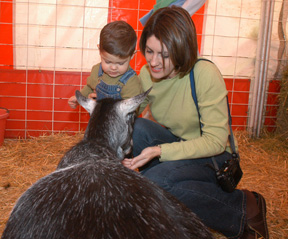
The stock show’s revenue comes from a variety of sources. In IRS documents, stock show officials didn’t break down its $12.5 million income by sources. But considering ticket prices ($8 for adults and $4 for children for the stock show and exhibition alone) and past attendance, ticket sales appear to account for about $5 million. Ticket prices for the 36 rodeo performances in the Will Rogers Memorial Coliseum average $22. At about 4,000 fans per show, rodeo tickets generate another $3 million. Parking on city-owned lots at $6 per car brings in about $1.8 million.
Other income is provided by exhibitors who rent space in the Amon Carter Jr. and Brown-Lupton exhibit halls. Based on the stock show’s web site, a 10-foot-by-10-foot space runs $1,250, which translates to about $1.3 million in income for the three-week run. Food concessionaires also pay rent for their spaces. And Talley Amusements, which runs the midway with its carnival rides and booths, pays for that privilege as well.
There are also fees to show animals – $30 per head for cattle, $50 for horses and llamas, $20 for sheep, goats, and swine. Based on more than 22,600 entries last year, those fees brought in about $3 million. According to insiders, the stock show makes at least another $500,000 from corporate and “special” sponsors. General Motors, for example, pays the stock show for the rights to exhibit their trucks near the show’s entrances.
More than $9 million of the $12.5 million or so in income is spent in putting on the shows, exhibits, and rodeo performances. According to documents filed with the IRS, setup and cleanup costs each year are about $600,000. A stock contract, payments to entertainers, and other costs for the rodeo total about $1.2 million. The organization spends about $800,000 on advertising and another $1.7 million on salaries for stock show employees.
The stock show has used some of its profits over the years to help pay for improvements and new facilities at the city-owned complex. Executive vice president Brad Barnes explained in an e-mail that in 1993, the stock show wanted a new livestock facility – known today as the Charlie and Kit Moncrief Building. It cost $11 million; the show contributed $7 million of that amount up front and agreed to pay the city $200,000 a year over 20 years to retire the additional $4 million in bonds.
The stock show “is a good lessee for the city,” Barnes said. He explained that, in consideration of the stock show’s underwriting of the new livestock building, the city cut the show’s lease payments in half – from $200,000 to $100,000. According to the contract, that annual lease payment will go back to $200,000 this year. The stock show must also contribute $20,000 to the city each year for improvements to the facilities, improvements that the show and the city collectively determine. But Barnes said the stock show goes further than the contract and contributed $356,000 for improvements last year.
“Since 1944, the Stock Show has paid $24,943,000 for improvements at the Will Rogers Center,” he said.
“From the [IRS] form you reviewed, you likely have noticed we have a very expensive operation,” Barnes said. “Therefore, without the revenues from the various sources we could not continue to stay in business … You can see the City benefits from the lease agreement in many ways.”
It’s difficult to compare other stock shows’ lease agreements to that in Fort Worth. The San Antonio Livestock Exposition pays that city $1.4 million for use of the Alamodome. The Houston Stock show has a similar deal to lease Reliant Stadium for about $1.6 million. Both those shows are bigger than Fort Worth’s, based on music concert and rodeo attendance, but actually tak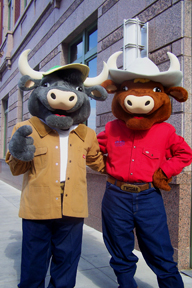 e up less space because Cowtown focuses much more on the stock show element.
e up less space because Cowtown focuses much more on the stock show element.
And there’s another interesting comparison. All three shows hand out scholarships for ranch and farm kids to study agriculture in college. San Antonio expects to give out $8.5 million in college scholarships this year; Houston will fund $4.86 million. In Fort Worth, which of the three has by far the strongest element of ranch heritage, the stock show has set aside only about $93,000 for scholarships. Percentagewise, San Antonio uses 34 percent of its revenues for scholarships, and Houston comes in at about 10 percent. Fort Worth’s share was less than one percent.
The stock show and rodeo aren’t the only events booked through the year at the Will Rogers complex, of course. In that comparison, too, the stock show’s deal looks mighty cozy.
In Barnes’ e-mail, the stock show vice president pointed out that other groups that lease part of the Will Rogers complex for events don’t pay for utilities and cleanup, as the stock show does, nor overtime for city workers.
But organizers of some of those other events still think they’re getting a much more expensive deal from Fort Worth.
The Fort Worth Original Gun Show leased the 100,000-square-foot Amon Carter Junior Exhibits Hall for seven shows last year, or 14 days in all. Gun show organizers sell 8-foot-wide spaces to exhibitors for $65 each. Up to 1,200 exhibitors can be accommodated.
The gun show owners rent the facility from the city for $14,000 for each two-day show, or about $98,000 for all the seven shows last year, plus renting 500 tables for the city at $4 per table. (The group gets its remaining tables from private contractors.)
So when all is added up, the Fort Worth Original Gun Show pays the city $112,000 to lease the 100,000 square feet of space for 14 days. By comparison, the Southwestern Exposition and Livestock pays the city about $1.4 million – in lease payments, utilities, and clean-up costs – for 3.7 million square feet of space for 30 days.
To put it another way, the gun show pays about 10 times as much as the stock show on a per-square-foot-per-day basis – and that’s not counting the stock show’s year-round office space.
“I understand the stock show brings in a lot more people than our shows do, but we still bring a lot of people into the city for our gun shows,” said Michelle Finucane, owner of the Fort Worth Original Gun Show. “But it sounds to me that [the stock show] has a really sweet deal.
“It makes me kind of mad, because they get all those proceeds from parking and concessions and ticket sales, and maybe the city should be getting a portion of those,” Finucane said. “Or maybe the city should charge the stock show more based on the space they use. But hey, what can we do about it? It’s the stock show, and they have a lot of clout in this town.”
If a promoter wants to rent the Will Rogers Coliseum for a rodeo or concert event, Fort Worth charges about $15,000 to $30,000 per night for use of the facility. The stock show puts on 36 rodeo shows over its three-week run. If the stock show organization was charged for the rodeo performances alone – not counting the space used by the whole stock show and exhibition elements – at the low-end rate of $15,000 per show, the lease cost would run $540,000.
Fort Worth Public Events Director Kirk Slaughter wouldn’t comment on the stock show’s lease and how it compares to other shows. He said he was too busy with stock show activities last week, and “since the Weekly has a copy of the contract, it will have all of the pertinent information relating to the financial agreement between the City and Stock Show.”
The American Quarter Horse Association (AQHA) held its World Youth Show at the Will Rogers Center from 1992 to last year. This year their show, which features 1,100 mostly teenage riders and 1,400 horses, will take place in Oklahoma City. The move was the result of Oklahoma revamping its State Fair Park for the AQHA, while the city of Fort Worth did not make improvements to the Will Rogers equestrian facilities.
“Our move had most to do with the improvements we needed to host our show,” said Tom Persechino, marketing director for the AQHA. “We were expanding and needed more practice arenas and better stall space for the horses. Fort Worth did not want to do that, and Oklahoma did.
“The fact of the matter is that Will Rogers is a very old facility and getting a little worn,” Persechino said. “It is time for a facelift for that facility. We loved our time in Fort Worth, because it has been the horse capital of the country. But other cities are seeing the value of these shows, and they are allocating facilities that are just so much better than the Will Rogers Center.”
The AQHA youth show is a weeklong event, and the economic impact is big for the host city. “The kids come with their parents and sisters and brothers, and the grandparents will usually fly in,” Persechino said. “Those family members stay in hotels and go out to eat every day. It is a big event.”
Persechino said there were other factors in the move beyond the aging facilities at Will Rogers. A lack of mid-priced hotel space close by “had our kids and their families scattered all over the place.” He also said a lack of restaurants that stayed open late was part of the problem. “We have kids working until 9 or 10 at night on their horses, and we just could not find much in Fort Worth open that late.”
Losing some of these horse shows has bigger economic impact than the stock show brings in, according to the owner of one bar and restaurant in the Cultural District, who asked that his name not be used. “We would see a big increase in business when that youth horse show came to town,” he said. “They would have more than 1,000 kids coming to town for a week, and they would bring their families along, and they would stay in hotels. They would like to get out and explore the town, and they would spend lots of money.
“The stock show doesn’t do that much for us,” he continued. “The exhibitors stay on the grounds for the whole day because of the long hours. Most stay with friends in the area to cut expenses. Those who buy tickets to get in are either locals or one-day-only visitors. So when they say the stock show brings in all these millions, well, I just don’t see it.”
Rodeo visitors may also be more likely than horse show fans to spend their money only within the Will Rogers grounds for another reason: Parking for the stock show costs $6 this year, and there are no in-and-out privileg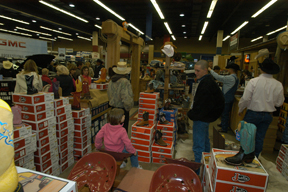 es.
es.
The restaurant/bar owner said the city pays too much attention to the stock show and not enough to the other horse show events. “Cities like Oklahoma City and Las Vegas are working hard to get these shows out of Fort Worth,” he said. “The city will do anything for the stock show, but they nitpick with these other groups. And if they keep going down that path, we are going to be losing more shows.”
And while the city cannot find the money needed to renovate their arena and barn areas for groups like the AQHA, they will likely find $16.6 million for what some believe is an unneeded Will Rogers-area parking garage – whose revenues may flow to the stock show.
The issue of parking money will likely be decided by Fort Worth City Council this year. Prior to 2006, the city shared equally with the stock show in revenue from the 12-acre parking lot just south of Harley Avenue. But an amendment to the lease that year permitted the stock show to keep all the $6-per-car parking money. Slaughter, who signed the agreement, would not comment on why the show needed all of that income.
In the meantime, Fort Worth has announced that it wants to build a 1,117-space parking garage on Montgomery Street next to the Fort Worth Museum of Science and History. City officials and the stock show leaders have said the new garage is needed for the stock show and other events. The need will be compounded, they say, if the city builds a new and larger rodeo arena near Harley Avenue and Montgomery Street. The arena would be built on part of the Harley Avenue lot, displacing current parking spaces. Once approved, the garage would be open in about a year.
The city has floated the idea that the city would operate the garage and use the parking fees to pay for the construction. City staffers are also considering the idea of changing all the surface parking around the Will Rogers Center from free to paid year-round, so if you are going to a flea market or a gun show or attending a museum, you might have to pay to park. At this point there is no formal proposal on either the garage or paid surface parking, according to Fort Worth spokeswoman Janice Thompson-Burgess, but she said it may be brought before the council this year.
There are some big problems with the parking garage proposal, and many have to do with the stock show. The new rodeo arena is just an idea at this point, one that might not come to fruition for a decade. So in the time between then and now, the need for the extra parking will likely be for just the stock show and perhaps a few other weekends a year.
The stock’s show’s lease with the city runs until 2023, with lease payments and revenue rules locked in, and it stipulates that the show keeps all parking revenues. So not only will the city council have to decide whether there is indeed a need for the garage, but it might have to negotiate with the stock show to see who keeps the revenues from that garage during its heaviest use period of the year.
Mark Johnson of Dallas was on the midway last Sunday, watching his 4-year-old son ride the miniature train. The boy waved to his family each time the train came around, a big smile on his face. It was a scene repeated throughout the midway, with parents and strollers as common as cowboy hats and boots.
Johnson, his wife, and their four kids spent about $200 for their day at the stock show. “I did not find anything too out of line” in terms of expenses, Johnson said. “The kids really enjoy this, and while we don’t come every year, it’s usually a good day to spend with the family.”
Johnson’s only complaint about prices was that there was no rodeo ticket discount for kids. “We would have liked to go to the rodeo, but I’m not going to spend $22 on a ticket for a 4-year-old,” he said.
But Johnson is typical for the one-day visitors to the stock show. He and his family will not be spending any money outside of the Will Rogers grounds; the entire $200 stayed with the stock show.
Joe Mac Duncan is an exhibitor whose money will be going into the Fort Worth economy. He’s a sales manager for Big Tex Trailers, a Mount Pleasant-based company that sells livestock trailers to ranchers. The company pays about $5,000 to lease about 90 feet o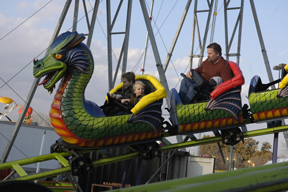 f sidewalk space on Burnett-Tandy Drive, right across from the show barns, for three weeks.
f sidewalk space on Burnett-Tandy Drive, right across from the show barns, for three weeks.
Duncan figures he will drop about $3,000 in the city for his hotel and restaurant meals. He’s staying in a hotel on University Drive where the nightly rate is $120. He’s been doing business at the stock show for the last seven years.
“It’s not that we do all sorts of sales during the show, but for us, the marketing and customer contacts we make during the show pay off throughout the year,” Duncan said. “We like this location. We’re right across the street from all the people who will use trailers.”
When told that Watt makes $425,000 running the show, Duncan said, “Sounds like quite a deal to me.” But the stock show managers “do a really good job of running this,” he said.
The people who run the Southwestern Exposition and Livestock Show may face questions in the future from folks who are harder to ignore than newspaper reporters.
The IRS has said it plans to change some rules this year on approved salary levels for nonprofit groups. Organizations will have to show that their staff salaries are comparable to other charitable groups and even for-profit businesses with similar revenues.
Nonprofits “will have to do independent reports to show the salaries paid out are comparable to others in groups that are similar,” Lampkin said. “The boards that decided on pay will have to have the information ready for the IRS to justify salaries. There is no law against the good ol’ boy network, but the high salaries of the Fort Worth stock show seem to have something to do with that.”




